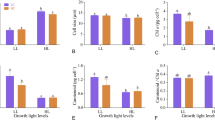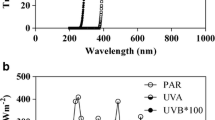Abstract
Ocean acidification due to atmospheric CO2 rise is expected to influence marine phytoplankton. Diatoms are responsible for about 40% of the total primary production in the ocean. In order to investigate the physiological response of marine diatom Thalassiosira pseudonana to ocean acidification, we grew the cells under ambient CO2 level (380 µatm) versus the elevated CO2 level (800 µatm) at a light level of 180 µmol m−2 s−1 for 30 generations. Our results showed that the elevated CO2 concentration caused a decrease of the effective photochemical efficiency of PSII \(\left( {{{F_{{\text{v}}}^{\prime } } \mathord{\left/ {\vphantom {{F_{{\text{v}}}^{\prime } } {F_{{\text{m}}}^{\prime } }}} \right. \kern-\nulldelimiterspace} {F_{{\text{m}}}^{\prime } }}} \right)\) and increase of the dark respiration in T. pseudonana. The intracellular carbonic anhydrase activity was suppressed and the photosynthetic affinity for CO2 was lowered in the high CO2-grown cells, reflecting a downregulation of the CO2 concentrating mechanism (CCM). PSI activity was enhanced to support an increase in ATP synthesis by cyclic electron transfer as required for transport of inorganic carbon and regulation of intracellular pH. The energetic benefit from the downregulation of CCM to growth as reported in other diatom species was not observed here in T. pseudonana.




Similar content being viewed by others
References
Badger, M. R., T. J. Andrews, S. Whitney, M. Ludwig, D. C. Yellowlees, W. Leggat & G. D. Price, 1998. The diversity and coevolution of Rubisco, plastids, pyrenoids, and chloroplast-based CO2-concentrating mechanisms in algae. Canadian Journal of Botany 76: 1052–1071.
Baragi, L. V., L. Khandeparker & A. C. Anil, 2015. Influence of elevated temperature and pCO2 on the marine periphytic diatom Navicula distans and its associated organisms in culture. Hydrobiologia 762: 127–142.
Burkhardt, S., G. Amoroso, U. Riebesell & D. Sültemeyer, 2001. CO2 and HCO3 − uptake in marine diatoms acclimated to different CO2 concentration. Liminology and Oceanography 46: 1378–1391.
Caldeira, K. & M. E. Wickett, 2003. Oceanography: anthropogenic carbon and ocean pH. Nature 425: 365.
Chen, S. & K. S. Kao, 2011. Solar ultraviolet radiation and CO2-induced ocean acidification interacts to influence the photosynthetic performance of the red tide alga Phaeocystis globosa (Prymnesiophyceae). Hydrobiologia 675: 105–117.
Chen, X. & K. Gao, 2003. Effect of CO2 concentrations on the activity of photosynthetic CO2 fixation and extracelluar carbonic anhydrase in the marine diatom Skeletonema costatum. Chinese Science Bulletin 48: 2616–2620.
Crawfurd, K. J., J. A. Raven, G. L. Wheeler, E. J. Baxter & I. Joint, 2011. The response of Thalassiosira pseudonana to long-term exposure to increased CO2 and decreased pH. PloS one 6: e26695.
Doney, S. C., V. J. Fabry, R. A. Feely & J. A. Kleypas, 2009. Ocean acidification: the other CO2 problem. Marine Science 1: 169–192.
Elzenga, J. T. M., H. Prins & J. Stefels, 2000. The role of extracellular carbonic anhydrase activity in inorganic carbon utilization of Phaeocystis globosa (Prymnesiophyceae): a comparison with other marine algae using the isotopic disequilibrium technique. Limnology and Oceanography 45: 372–380.
Gao, K. S., J. T. Xu, G. Gao, Y. H. Li, D. A. Hutchins, B. Q. Huang, L. Wang, Y. Zheng, P. Jin, X. N. Gai, D. P. Hader, W. Li, K. Xu, N. N. Liu & U. Riebesell, 2012. Rising CO2 and increased light exposure synergistically reduce marine primary productivity. Nature Climate Change 2: 519–523.
Giordano, M., J. Beardall & J. A. Raven, 2005. CO2 concentrating mechanisms in algae: mechanisms, environmental modulation, and evolution. Annual Reviews Plant Biology 56: 99–131.
Gran, G., 1952. Determination of the equivalence point in potentiometric titrations of seawater with hydrochloric acid. Acta Oceanologica Sinica 5: 209–218.
Guillard, R. R. L. & J. H. Ryther, 1962. Studies of marine planktonic diatoms. Canadian Journal of Microbiology Research 8: 229–239.
Hopkinson, B. M., C. L. Dupont, A. E. Allen & F. M. Morel, 2011. Efficiency of the CO2-concentrating mechanism of diatoms. Proceedings of the National Academy of Sciences 108: 3830–3837.
Intergovemmental panel on climate change (IPCC), 2001. Climate Change 2001: Contribution of Working Groups and to the Third Assessment Report of the Intergovemental Panel on Climate Change, the Scientific Basis. Cambridge University Press, Cambridge.
Jassby, A. D. & T. Platt, 1976. Mathematical formulation of the relationship between photosynthesis and light for phytoplankton. Limnology and oceanography 21: 540–547.
Kaplan, A. & L. Reinhold, 1999. CO2 concentrating mechanisms in photosynthetic microorganisms. Annual Review of Plant Physiology and Plant Molecular Biology 50: 539–570.
Kim, J. M., K. Lee, K. Shin, J. H. Kang, H. W. Lee, M. Kim, P. G. Jang & M. C. Jang, 2006. The effect of seawater CO2 concentration on growth of a natural phytoplankton assemblage in a controlled mesocosm experiment. Liminology and Ocanography 51: 1629–1636.
King, A. L., S. A. Sanudo-Wilhelmy, K. Leblanc, D. A. Hutchins & F. Fu, 2011. CO2 and vitamin B12 interactions determine bioactive trace metal requirements of a subarctic Pacific diatom. The ISME Journal 5: 1388–1396.
Lewis, E., D. Wallace & L. J. Allison, 1998. Program developed for CO2 system calculations. Carbon Dioxide Information Analysis Center, managed by Lockheed Martin Energy Research Corporation for the US Department of Energy Tennessee.
Li, G. & D. A. Campbell, 2013. Rising CO2 interacts with growth light and growth rate to alter photosystem II photoinactivation of the coastal diatom Thalassiosira pseudonana. PLoS One 8: e55562.
Li, Q. & D. T. Canvin, 1998. Energy sources for HCO3 − and CO2 transport in air-grown cells of synechococcus UTEX 625. Plant Physiology 116: 1125–1132.
Li, Y., J. Xu & K. Gao, 2014. Light-modulated responses of growth and photosynthetic performance to ocean acidification in the model diatom Phaeodactylum tricornutum. PloS One 9: e96173.
Low-Décarie, E., G. F. Fussmann & G. Bell, 2011. The effect of elevated CO2 on growth and competition in experimental phytoplankton communities. Global Change Biology 17: 2525–2535.
Martin, C. I. & P. D. Tortell, 2008. Bicarbonate transport and extracellular carbonic anhydrase in marine diatoms. Physiologia Plantarum 133: 106–116.
McCarthy, A., S. P. Rogers, S. J. Duffy & D. A. Campbell, 2012. Elevated carbon dioxide differentially alters the photophysiology of Thalassiosira pseudonana (bacillariophyceae) and Emiliania huxleyi (haptophyta). Journal of Phycology 48: 635–646.
Morel, F. M., J. Rueter, D. M. Anderson & R. Guillard, 1979. Aquil: a chemically defined phytoplankton culture medium for trace metal studies. Journal of Phycology 15: 135–141.
Nimer, N. A., M. D. Iglesias-Rodriguez & M. J. Merrett, 1997. Bicarbonate utilization by marine phytoplankton species. Journal of Phycology 33: 625–631.
Ogawa, T., A. Miyano & Y. Inoue, 1985. Photosystem-I-driven inorganic carbon transport in the cyanobacterium, Anacystis nidulans. Biochimica et Biophysica Acta 808: 77–84.
Porra, R. J., 2002. The chequered history of the development and use of simultaneous equations for the accurate determination of chlorophylls a and b. Discoveries in Photosynthesis 20: 633–640.
Raven, J., 1991. Physiology of inorganic C acquisition and implications for resource use efficiency by marine phytoplankton: relation to increased CO2 and temperature. Plant, Cell & Environment 14: 779–794.
Reinfelder, J. R., 2011. Carbon concentrating mechanisms in eukaryotic marine phytoplankton. Marine Science 3: 291–315.
Riebesell, U. & P. D. Tortell, 2011. Effects of ocean acidification on pelagic organisms and ecosystems. In Gattuso, J.-P. & L. Hansson (eds), Ocean Acidification. Oxford University Press, Oxford: 99–121.
Roberts, K., E. Granum, R. C. Leegood & J. A. Raven, 2007. C3 and C4 pathways of photosynthetic carbon assimilation in marine diatoms are under genetic, not environmental, control. Plant Physiology 145: 230–235.
Rost, B., U. Riebesell, S. Burkhardt & D. Sültemeyer, 2003. Carbon acquisition of bloom-forming marine phytoplankton. Limnology and Oceanography 48: 55–67.
Sabine, C. L., R. A. Feely, N. Gruber, R. M. Key, K. Lee, J. L. Bullister, R. Wanninkhof, C. Wong, D. W. Wallace & B. Tilbrook, 2004. The oceanic sink for anthropogenic CO2. Science 305: 367–371.
Sasaki, T., N. A. Pronina, M. Maeshima, I. Iwasaki, N. Kurano & S. Miyachi, 1999. Development of vacuoles and vacuolar H+-ATPase activity under extremely high CO2 conditions in Chlorococcum littorale cells. Plant Biology 1: 68–75.
Satoh, A., N. Kurano & S. Miyachi, 2001. Inhibition of photosynthesis by intracellular carbonic anhydrase in microalgae under excess concentration of CO2. Photosynthesis Research 68: 215–224.
Satoh, A., N. Kurano, H. Senger & S. Miyachi, 2002. Regulation of energy balance in photosystems in response to changes in CO2 concentrations and light intensities during growth in extremely-high-CO2 −tolerant green microalgae. Plant and Cell Physiology 43: 440–451.
Silverman, D. N., 1991. The catalytic mechanism of carbonic anhydrase. Canadian Journal of Botany 69: 1070–1078.
Sobrino, C., M. L. Ward & P. J. Neale, 2008. Acclimation to elevated carbon dioxide and ultraviolet radiation in the diatom Thalassiosira pseudonana: effects on growth, photosynthesis, and spectral sensitivity of photoinhibition. Limnology and Oceanography 53: 494–505.
Sukenik, A., D. Tchernov, A. Kaplan, E. Huertas, L. M. Lubian & A. Livne, 1997. Uptake, efflux, and photosynthetic utilization of inorganic carbon by the marine eustigmatophyte Nannochloropsis sp. Journal of Phycology 33: 969–974.
Tchernov, D., M. Hassidim, B. Luz, A. Sukenik, L. Reinhold & A. Kaplan, 1997. Sustained net CO2 evolution during photosynthesis by marine microorganism. Current Biology 7: 723–728.
Tew, K. S., Y. C. Kao, F. C. Ko, J. Kuo, P. J. Meng, P. J. Liu & D. C. Glover, 2014. Effects of elevated CO2 and temperature on the growth, elemental composition, and cell size of two marine diatoms: potential implications of global climate change. Hydrobiologia 741: 79–87.
Trimborn, S., D. Wolf-Gladrow, K.-U. Richter & B. Rost, 2009. The effect of pCO2 on carbon acquisition and intracellular assimilation in four marine diatoms. Journal of Experimental Marine Biology and Ecology 376: 26–36.
Van Kooten, O. & J. Snell, 1990. Progress in fluorescence research and nomenclature for quenching analysis. Photosynthesis Research 25: 147–150.
Wilbur, K. M. & N. G. Anderson, 1948. Electrometric and colorimetric determination of carbonic anhydrase. Journal of Biological Chemistry 176: 147–154.
Wu, Y., K. Gao & U. Riebesell, 2010. CO2-induced seawater acidification affects physiological performance of the marine diatom Phaeodactylum tricornutum. Biogeosciences 7: 2915–2923.
Yang, G. & K. Gao, 2012. Physiological responses of the marine diatom Thalassiosira pseudonana to increased pCO2 and seawater acidity. Marine Environmental Research 79: 142–151.
Acknowledgments
This research was supported by the National Natural Science Foundation of China (No. 31270452) and the Research Project of Chinese Ministry of Education (No 213026A); the Special Program for National Key Basic Research of China (No. 2014CB460601), the International S & T cooperation program of China (No. 2014DFE70070), and the Natural Science Foundation of Hubei Province (2014CFB607).
Author information
Authors and Affiliations
Corresponding author
Additional information
Handling editor: Luigi Naselli-Flores
Rights and permissions
About this article
Cite this article
Shi, Q., Xiahou, W. & Wu, H. Photosynthetic responses of the marine diatom Thalassiosira pseudonana to CO2-induced seawater acidification. Hydrobiologia 788, 361–369 (2017). https://doi.org/10.1007/s10750-016-3014-1
Received:
Revised:
Accepted:
Published:
Issue Date:
DOI: https://doi.org/10.1007/s10750-016-3014-1




